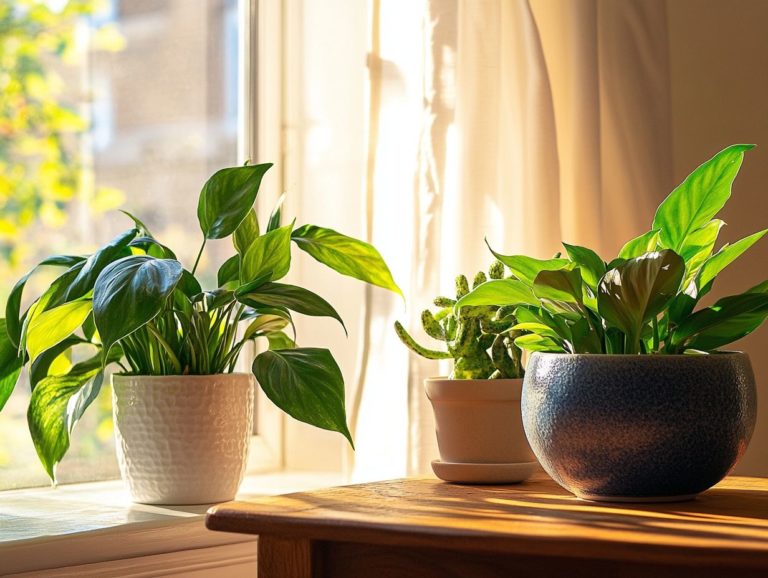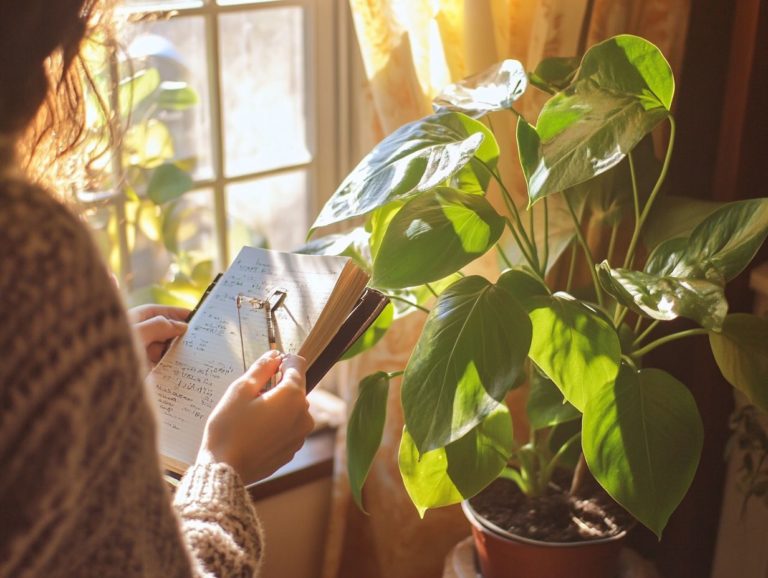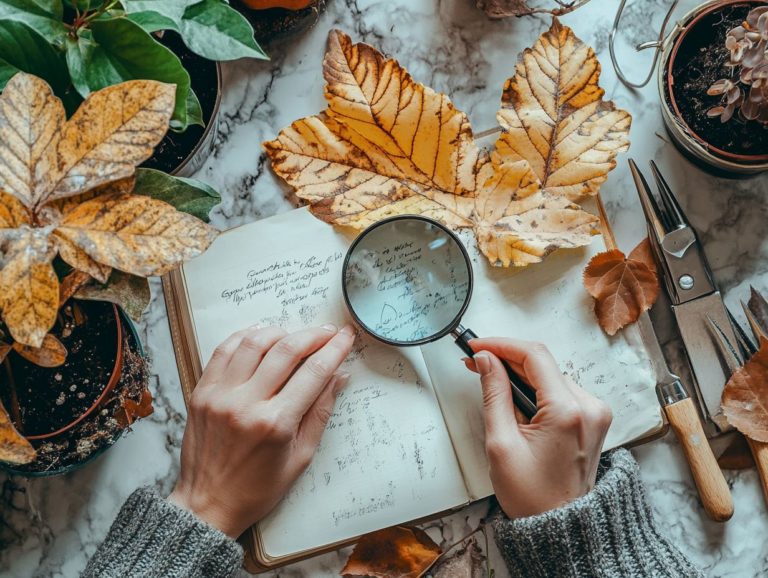What to Look for When Buying Indoor Plants?
Indoor plants, or houseplants, are more than just decor. They can significantly enhance the air quality in your home and uplift your mood.
Whether you’re a plant expert or new to greenery, it s essential to understand what to consider before purchasing. This is especially important for beginner plants.
Consider lighting and temperature needs, plant size, pot aesthetics, and the safety of pets and children. Choosing the right plant requires careful thought.
This article will delve into the myriad benefits of indoor plants, explore the various types available, and offer you practical tips for selection and care.
Get ready to transform your home into a vibrant sanctuary!
Contents
Key Takeaways:
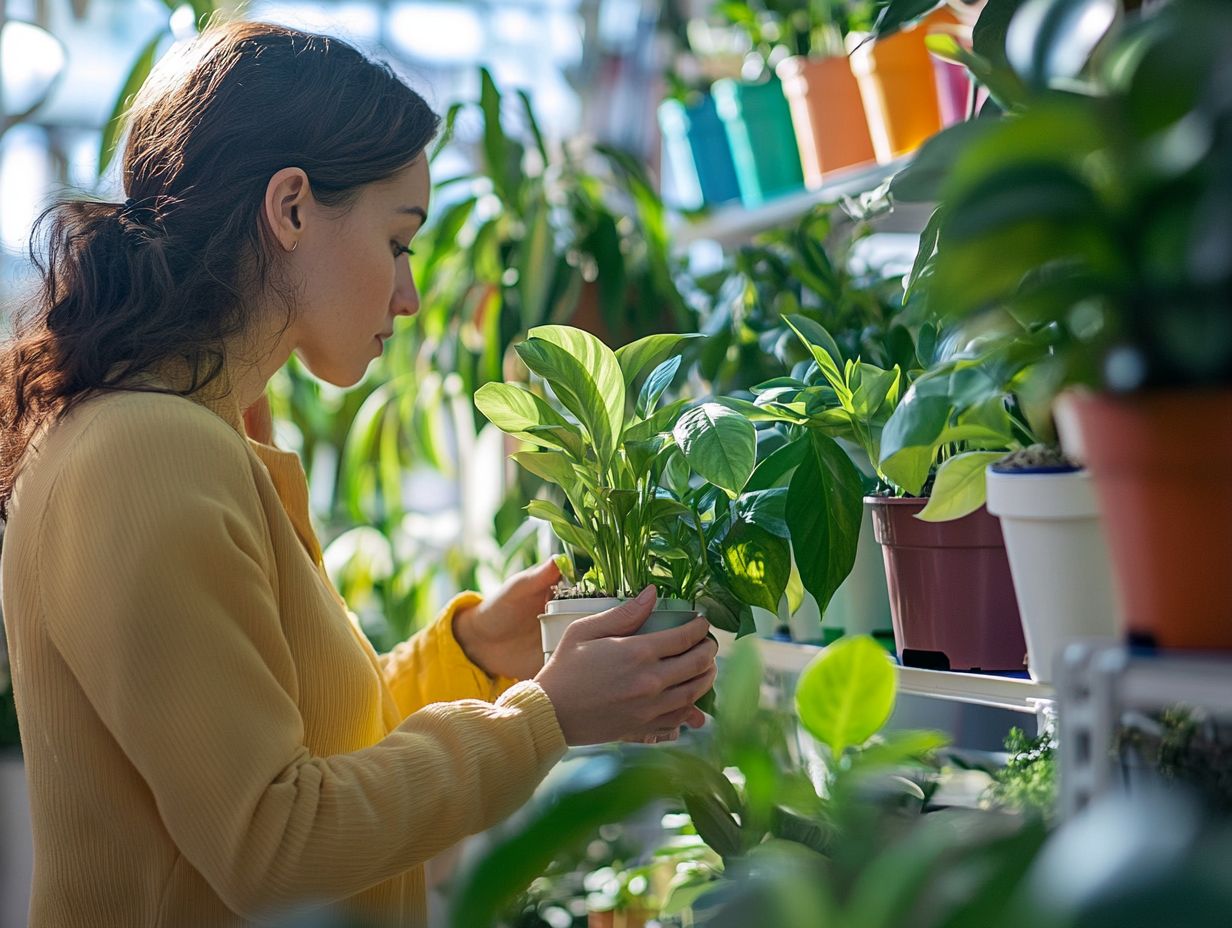
- Indoor plants boost air quality and mood, making them a must-have for any home. The right decorative pot can enhance their presentation.
- When buying indoor plants, consider lighting and temperature requirements, size and placement, sunlight needs, and pet and child safety.
- Choose low-maintenance plants that serve a specific purpose. Regularly inspect for pests and follow proper watering and fertilizing guidelines.
Benefits of Indoor Plants
The benefits of indoor plants extend far beyond mere decoration. They enrich various facets of your living environment while elevating your overall well-being.
Vibrant houseplants like the snake plant and rubber tree not only purify the air by filtering out toxins, but they also enhance your mood and sharpen your mental clarity.
Imagine transforming a simple room into a serene indoor jungle. Create a sanctuary that nurtures both your physical health and psychological comfort.
Understanding light and watering needs enhances your connection with plants, turning a simple hobby into a rewarding experience.
Improving Air Quality and Mood
Indoor plants like the rubber tree and snake plant do more than just enhance the beauty of your space. They work wonders for your air quality and elevate your mood.
Research indicates that specific plant species excel at filtering out common indoor pollutants such as formaldehyde and benzene. A NASA study showcased the impressive air-purifying abilities of these plants, revealing that they can eliminate up to 87% of toxins within just 24 hours.
But the benefits don t stop there. Being surrounded by greenery can significantly reduce stress and cultivate a sense of tranquility. By integrating these botanical companions into your home decor, you achieve aesthetic appeal while transforming your living spaces into vibrant retreats that promote mental clarity and relaxation.
Factors to Consider Before Buying Indoor Plants
Before you immerse yourself in the delightful realm of plant shopping, it s vital to take a moment to consider key factors that will guarantee your indoor plants flourish in your unique environment.
Understanding the light requirements and temperature preferences of various varieties whether you’re leaning towards low-maintenance, pet-safe options or more decorative choices is essential for their enduring success.
Furthermore, contemplating the size and placement of your plants will help you avoid issues like roots that grow too tightly in the pot and ensure they harmoniously complement your home decor.
Lighting and Temperature Requirements
Understanding the lighting and temperature needs is essential for the success of your indoor plants, such as the rubber tree and Monstera deliciosa. Each plant has its own preferences, ranging from low-light lovers to those that bask in bright conditions.
For instance, snake plants and pothos thrive in lower light levels, making them perfect for those dim corners in your home. On the other hand, rubber trees and Monsteras prefer bright, indirect light. Not giving them enough light can cause them to grow tall and spindly, which isn’t attractive.
Temperature matters, too. Most tropical plants flourish in a cozy range between 65 F and 80 F, but you’ll want to steer clear of sudden drafts or extreme heat that can throw them off balance. Regularly checking the moisture in the soil can help you fine-tune your care routine, adjusting watering schedules to meet the specific needs of each plant species.
Choosing the Right Size and Placement for Your Plants
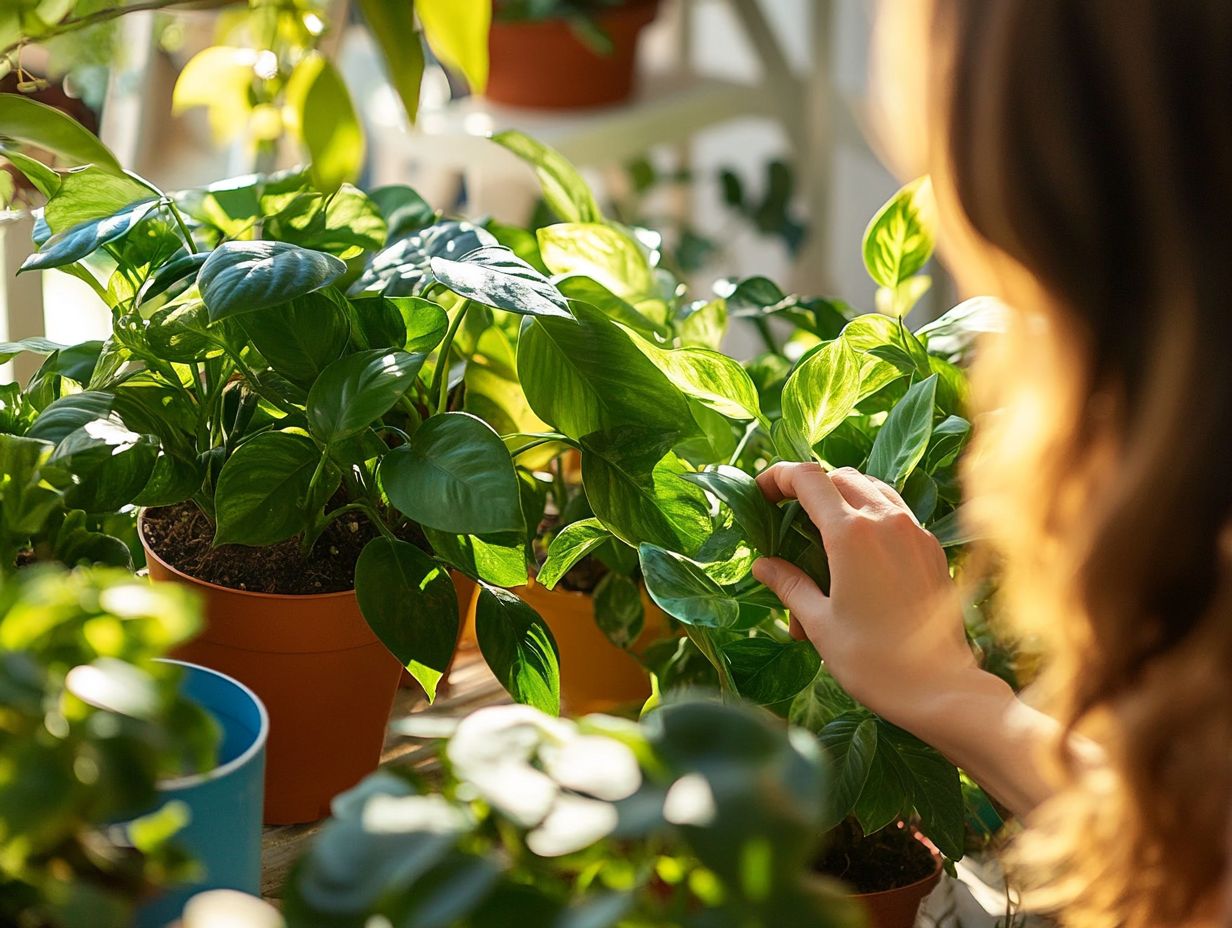
Selecting the right size and placement for your indoor plants can profoundly influence their health and elevate your home s visual appeal.
It s crucial to understand the unique characteristics and growth habits of various species to cultivate a thriving indoor garden. For example, a compact Pilea peperomioides can infuse life into smaller spaces like a desk or shelf without overwhelming the area.
In contrast, a Monstera deliciosa, with its striking foliage, deserves a more spacious nook where it can grow freely and make a dramatic statement, especially when paired with a stylish decorative pot.
Choosing the appropriate sizes helps to avoid crowded roots, allowing your plants to truly flourish. By positioning them near natural light sources, you enhance their vitality and create a seamless blend of nature and decor within your home.
Pet and Child Safety
When selecting indoor plants, prioritizing the safety of your pets and children is essential, especially with species like English ivy, which can pose risks.
Consider not only the visual appeal that greenery brings but also the well-being of every member of your household. Ensure that you choose pet-safe plants. Pets, such as cats and dogs, are naturally curious and may be tempted to nibble on leaves, while young children tend to explore their surroundings in ways that could lead to accidental ingestion.
By understanding which plants are harmful or safe, you can significantly reduce the likelihood of emergencies. Resources like the ASPCA offer comprehensive lists that serve as valuable guides for your selections.
Creating a safe indoor environment brings peace of mind, allowing you to enjoy the beauty and benefits of indoor gardening without worry. Imagine transforming your home with beautiful plants while keeping your loved ones safe and happy!
Types of Indoor Plants
You’ll discover an impressive array of indoor plants tailored to suit various needs, preferences, and levels of care. This diverse selection makes it effortless for both newcomers and seasoned plant aficionados to identify the perfect addition to their space.
Low Maintenance Options
Low-maintenance options like the snake plant and rubber tree are ideal for busy individuals or beginners who wish to introduce indoor greenery without the fuss.
These plants thrive in various lighting conditions, making them adaptable to any space, and they require minimal watering perfect for those who may occasionally forget to tend to their plants.
For example, the snake plant can go weeks without water and still look vibrant and healthy. Meanwhile, the rubber tree s air-purifying capabilities enhance its appeal, contributing to a cleaner indoor environment.
With their resilience and forgiving nature, these plants are not only visually appealing but also support a healthy lifestyle, catering beautifully to anyone juggling multiple commitments.
Plants for Specific Purposes
Choosing indoor plants can enhance your living space. Consider their roles, like air purification or visual appeal.
For instance, the Monstera Deliciosa is known for its beautiful leaves. It also filters harmful toxins from the air.
In contrast, English ivy adds character with its lovely cascading growth.
When it comes to care, the Monstera thrives in bright, indirect light. Water it when the topsoil feels dry.
English ivy is more adaptable; it flourishes in various light conditions but enjoys consistent moisture.
Choosing the perfect indoor plant can transform your home, striking a balance between beauty and functionality.
Tips for Choosing and Caring for Indoor Plants
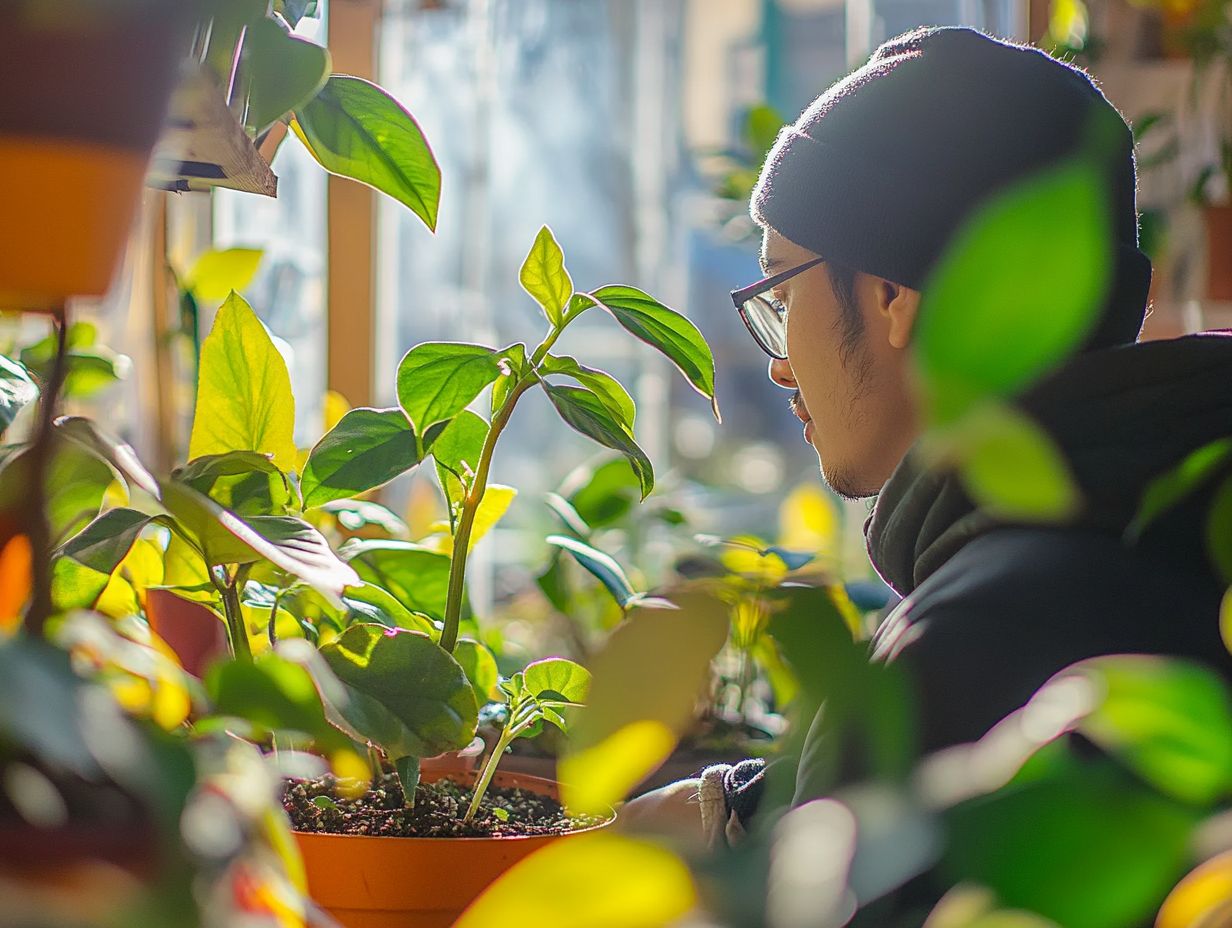
Effective plant care instructions are vital for nurturing your indoor plants. This includes understanding their watering schedule and managing pests.
Inspecting for Pests and Diseases
Regularly checking your indoor plants for pests and diseases is essential for maintaining their health and longevity.
Be attentive to symptoms like wilting leaves, discoloration, or sticky residue. These can indicate an infestation.
Common pests, such as aphids, spider mites, and mealybugs, thrive indoors. Look for yellowing leaves or visible webbing as signs.
To prevent these nuisances, ensure proper air circulation, maintain optimal humidity levels, and regularly clean the leaves.
If a problem does arise, using natural remedies or insecticidal soaps can effectively treat the infested plants, helping them bounce back to their vibrant best.
Watering and Plant Food Guidelines
Establishing a consistent watering schedule and understanding plant food is essential for effective indoor plant care.
Each plant has unique needs. A good rule of thumb is to check the top inch of soil for moisture before watering.
For example, succulents and cacti thrive in drier conditions and should be watered less frequently, while tropical varieties may need more hydration.
Fertilization is best during the growing season. Use balanced, water-soluble plant food every 4-6 weeks.
Quality soil is crucial it anchors the plant and provides nutrients while ensuring adequate drainage.
Adjust your care routines with the changing seasons. Increase watering during warm months and reduce it in cooler ones to prevent overwatering.
Frequently Asked Questions
What Should You Look for in a New Indoor Plant?
When buying indoor plants, consider several factors to ensure you choose the right plant for your space. Here are important aspects to look for:
- Size: Make sure the plant will fit in your chosen location and won’t outgrow its pot too quickly.
- Light Requirements: Know how much sunlight your chosen plant needs and ensure your space can accommodate it.
- Watering Needs: Some plants require more frequent watering than others, so choose a plant that fits your schedule.
- Pest and Disease Resistance: Look for healthy, pest-free plants to avoid unwanted guests.
- Air Purification Abilities: Many indoor plants improve air quality, so consider this when selecting.
- Personal Preference: Ultimately, choose a plant that you find visually appealing and will bring you joy in your space.
Why is it important to consider the size when buying indoor plants?
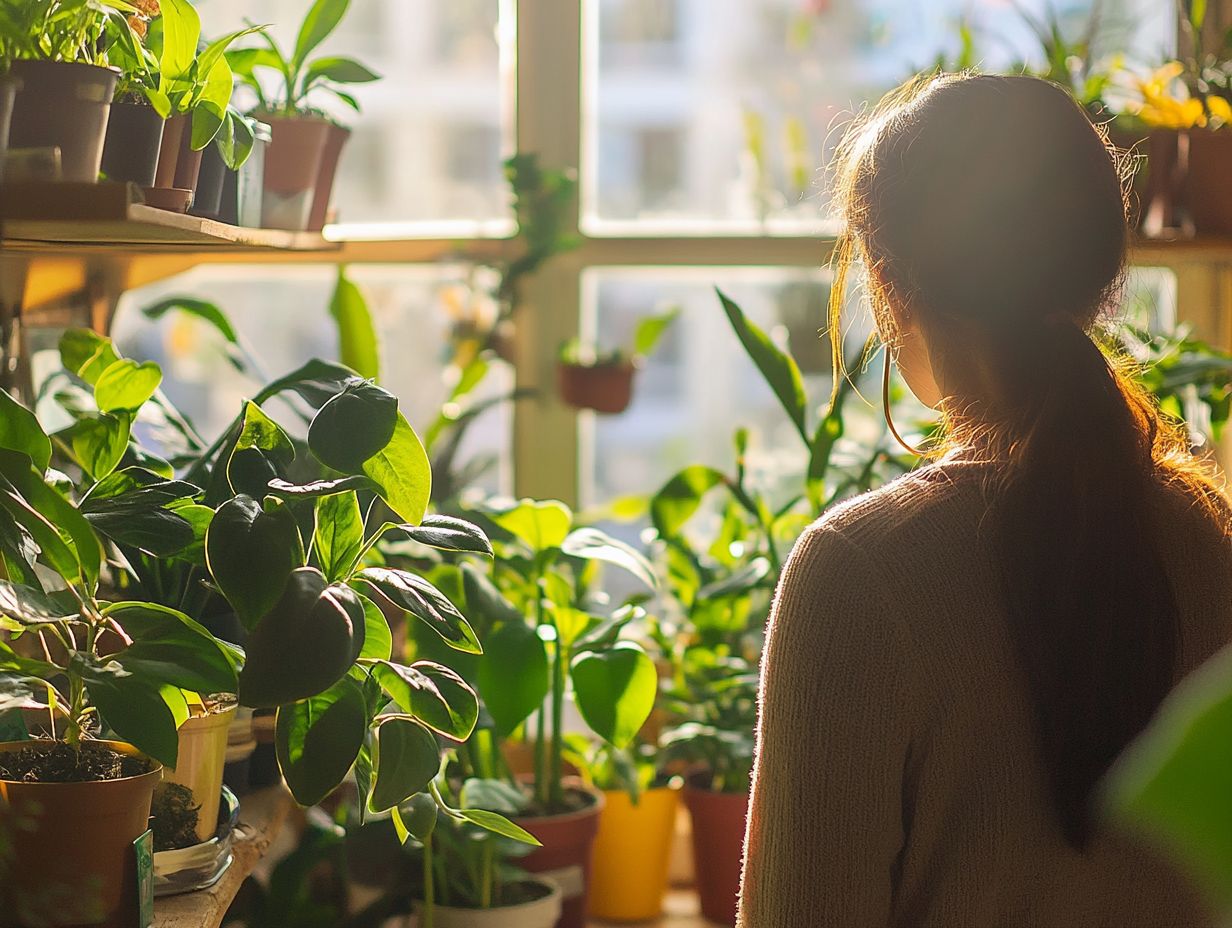
Choosing the right size plant is crucial for the plant’s health and the look of your space. Ensure the plant has enough room to grow without feeling cramped in its pot.
A plant that is too large may not get enough light or air circulation. This can lead to health issues down the line.
Do indoor plants have different light requirements?
Yes, indoor plants have different light needs. Some thrive in direct sunlight, while others prefer indirect or low light.
Research the light requirements of each plant before buying. This ensures they get the right amount of light in your home.
How often should I water my indoor plants?
Watering frequency varies by plant type and location. Some plants may need daily watering, while others require it only once a week.
Research your plants’ watering needs and adjust based on your home conditions. This helps keep them healthy.
How can I ensure my indoor plants are pest-free?
To avoid bringing pests home, inspect the plants thoroughly before purchasing. Look for signs like webs, bugs, or discolored leaves.
If you find pests, isolate the infested plant immediately. Treat it right away to stop the pests from spreading.
Can indoor plants improve air quality?
Absolutely! Many indoor plants can work wonders in cleaning the air by removing toxins and pollutants. This is especially helpful for those in urban areas with poor air quality.
Keep this in mind when selecting indoor plants. They can enhance your space while improving the air quality at home.

